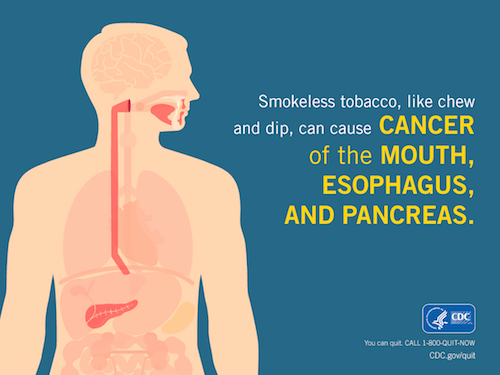Smokeless Tobacco: Health Effects
On This Page
Smokeless tobacco is associated with many health problems. Using smokeless tobacco:
- Can lead to nicotine addiction1,2
- Causes cancer of the mouth, esophagus (the passage that connects the throat to the stomach), and pancreas (a gland that helps with digestion and maintaining proper blood sugar levels)1,2
- Is associated with diseases of the mouth1,3
- Can increase risks for early delivery and stillbirth when used during pregnancy2
- Can cause nicotine poisoning in children4
- May increase the risk for death from heart disease and stroke1,3
Using smokeless products can cause serious health problems.
Protect your health; don’t start. If you do use them, quit.
- Many smokeless tobacco products contain cancer-causing chemicals.1,6
- The most harmful chemicals are tobacco-specific nitrosamines, which form during the growing, curing, fermenting, and aging of tobacco. The amount of these chemicals varies by product.1
- The higher the levels of these chemicals, the greater the risk for cancer.2
- Other chemicals found in tobacco can also cause cancer. These include:6
- A radioactive element (polonium-210) found in tobacco fertilizer
- Chemicals formed when tobacco is cured with heat (polynuclear aromatic hydrocarbons—also known as polycyclic aromatic hydrocarbons)
- Harmful metals (arsenic, beryllium, cadmium, chromium, cobalt, lead, nickel, mercury)
- Smokeless tobacco causes cancer of the mouth, esophagus, and pancreas.1
- World Health Organization. IARC Monographs on the Evaluation of Carcinogenic Risks to Humans. Volume 89: Smokeless Tobacco and Some Tobacco-Specific N-Nitrosamines.[PDF–3.18 MB] Lyon (France): World Health Organization, International Agency for Research on Cancer, 2007 [accessed 2014 Oct 31].
- U.S. Department of Health and Human Services.The Health Consequences of Smoking—50 Years of Progress: A Report of the Surgeon General. Atlanta: U.S. Department of Health and Human Services, Centers for Disease Control and Prevention, National Center for Chronic Disease Prevention and Health Promotion, Office on Smoking and Health, 2014 [accessed 2014 Oct 31].
- Piano MR, Benowitz NL, Fitzgerald GA, Corbridge S, Heath J, Hahn E, et al. Impact of Smokeless Tobacco Products on Cardiovascular Disease: Implications for Policy, Prevention, and Treatment: A Policy Statement from the American Heart Association. Circulation 2010;122(15):1520–44 [cited 2014 Oct 31].
- Connolly GN, Richter P, Aleguas A Jr, Pechacek TF, Stanfill SB, Alpert HR. Unintentional Child Poisonings Through Ingestion of Conventional and Novel Tobacco Products. Pediatrics 2010;125(5):896–9 [cited 2014 Oct 31].
- Lund I, Scheffels J. Smoking and Snus Use Onset: Exploring the Influence of Snus Debut Age on the Risk for Smoking Uptake With Cross-Sectional Survey Data. Nicotine and Tobacco Research 2014;16(6):815–9 [cited 2014 Oct 31].
- Stanfill SB, Connolly GN, Zhang L, Jia LT, Henningfield JE, Richter P, et al. Global Surveillance of Oral Tobacco Products: Total Nicotine, Unionised Nicotine and Tobacco-Specific N-Nitrosamines. Tobacco Control 2011 May;20(3):e2. doi:10.1136/tc.2010.037465 [cited 2014 Oct 31].
- California Environmental Protection Agency. Safe Drinking Water and Toxic Enforcement Act of 1986: Chemicals Known to the State to Cause Cancer or Reproductive Toxicity (November 23, 2018). [PDF–23.6 KB] California Environmental Protection Agency, Office of Environmental Health Hazard Assessment [accessed 2014 Oct 31].



